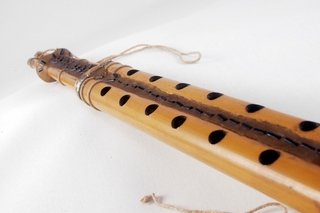Zummara Sittawiyya
Double clarinet (422.22). Its typological origin may be traced up to the memet of Ancient Egypt, first documented ca. 2700 a.C. Since the New Empire, this type of clarinet and, later, its descendants were connected with folk music.
Nowadays these instruments are spread out in many countries of the Arab World, bearing different names according to their localization and the variants in the make.
Basically, the zummara consists of two parallel cylindrical canes with one or two sections and, in general, of the same length.
Both canes are joined by means of a thread, wax and tar. The number of fingerholes ranges between four (rab'awiyya) and six (sittawiyya) pairs. These front and equidistant fingerholes are stopped simultaneously with the phalanxes.There are, however, some designs in which one of the canes has no holes, therefore producing only one drone note.
The beating reeds are cut in the walls of each cane in a slightly different way. This produces a small variation between the frequency of the tubes, thus causing the characteristic tremolous timbre of this clarinet. It is performed by mouthing all the reeds while the player continues to breathe through his nose. As the volume of air is kept constant inside the mouth, a continuous sound is created.
The zummara is a solo and shepherd instrument, though sometimes it is sounded in popular feasts, then being accompanied by a goblet shaped membranophone.
L. 43 x 0 of each cane 1.8 cm.
Gift, Dr. Emilio Azzarini's Collection, 1964. IM 214







